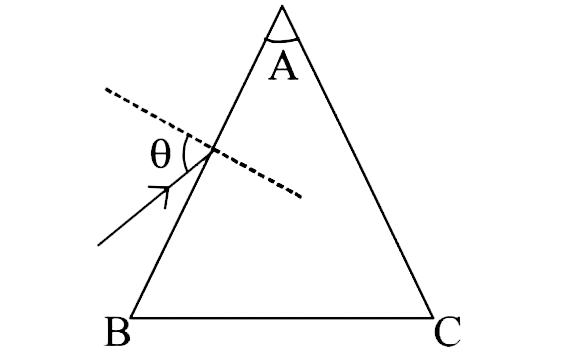A glass prism has a refractive angle of 90∘ and a refractive index of 1.5. A ray is incident at an angle of 30∘. The ray emerges from an adjacent face at an angle of
60∘
30∘
45∘
the ray does not emerge
The correct Answer is:D
To solve the problem step by step, we will follow the principles of refraction and apply Snell's law.
Step 1: Identify Given Values
- Refractive angle of the prism (A) = 90°
- Refractive index of glass (μ) = 1.5
- Angle of incidence (i) = 30°
Step 2: Calculate the Critical Angle
The critical angle (θc) can be calculated using the formula:
θc=sin−1(1μ)
Substituting the value of μ:
θc=sin−1(11.5)=sin−1(23)≈41.8°
Step 3: Apply Snell's Law at the First Surface
Using Snell's law at the first surface (air to prism):
μair⋅sin(i)=μglass⋅sin(r1)
Where:
- μ_air = 1 (for air)
- i = 30°
- μ_glass = 1.5
- r_1 = angle of refraction in the prism
Substituting the values:
1⋅sin(30°)=1.5⋅sin(r1)
Since sin(30°)=12:
12=1.5⋅sin(r1)
sin(r1)=12⋅1.5=13
Now, calculate r1:
r1=sin−1(13)≈19.5°
Step 4: Calculate the Angle of Refraction at the Second Surface
The angle of the prism (A) is given by:
A=r1+r2
Where r2 is the angle of refraction at the second surface. Given that A=90°:
90°=19.5°+r2
Solving for r2:
r2=90°−19.5°=70.5°
Step 5: Check if the Ray Emerges
Now, we need to check if r2 is greater than the critical angle:
- Critical angle θc≈41.8°
- r2=70.5°
Since r2 (70.5°) is greater than the critical angle (41.8°), the ray will not emerge from the second surface.
Conclusion
The ray does not emerge from the adjacent face of the prism.
Final Answer
The ray emerges from the adjacent face at an angle of not applicable (it does not emerge).
---
- Refractive angle of the prism (A) = 90°
- Refractive index of glass (μ) = 1.5
- Angle of incidence (i) = 30°
The critical angle (θc) can be calculated using the formula:
θc=sin−1(1μ)
Substituting the value of μ:
θc=sin−1(11.5)=sin−1(23)≈41.8°
Using Snell's law at the first surface (air to prism):
μair⋅sin(i)=μglass⋅sin(r1)
Where:
- μ_air = 1 (for air)
- i = 30°
- μ_glass = 1.5
- r_1 = angle of refraction in the prism
1⋅sin(30°)=1.5⋅sin(r1)
Since sin(30°)=12:
12=1.5⋅sin(r1)
sin(r1)=12⋅1.5=13
Now, calculate r1:
r1=sin−1(13)≈19.5°
The angle of the prism (A) is given by:
A=r1+r2
Where r2 is the angle of refraction at the second surface. Given that A=90°:
90°=19.5°+r2
Solving for r2:
r2=90°−19.5°=70.5°
Now, we need to check if r2 is greater than the critical angle:
- Critical angle θc≈41.8°
- r2=70.5°
The ray does not emerge from the adjacent face of the prism.
The ray emerges from the adjacent face at an angle of not applicable (it does not emerge).
Topper's Solved these Questions
- RAY OPTICSBook:DC PANDEY ENGLISHChapter:RAY OPTICSExercise:medical entrance special format question
Explore 23 Videos
- RAY OPTICSBook:DC PANDEY ENGLISHChapter:RAY OPTICSExercise:Medical entrance gallary
Explore 76 Videos
- RAY OPTICSBook:DC PANDEY ENGLISHChapter:RAY OPTICSExercise:Checkpoint 9.7
Explore 10 Videos
- NUCLEIBook:DC PANDEY ENGLISHChapter:NUCLEIExercise:C MADICAL ENTRANCES GALLERY
Explore 46 Videos
- REFLECTION OF LIGHTBook:DC PANDEY ENGLISHChapter:REFLECTION OF LIGHTExercise:Subjective
Explore 9 Videos
Similar Questions
A ray of light is incident at an angle of 60∘ on one face of a prism which has refracting angle of 30∘ . The ray emerging out of the prism makes an angle of 30∘ with the incident ray. If the refractive index of the material of the prism is μ=√a , find the value of a .
View SolutionOne face of a prism with a refrective angle of 30∘ is coated with silver. A ray of light incident on another face at an angle of 45∘ is refracted and reflected from the silver coated face and retraces its path. What is the refractive index of the prism?
View SolutionOne face of a prism with a refrective angle of 30∘ is coated with silver. A ray of light incident on another face at an angle of 45∘ is refracted and reflected from the silver coated face and retraces its path. What is the refractive index of the prism?
View SolutionA ray EF of monochromatic light is incident on the refracting surface AB of a regular glass prism ( refractive index=1.5) at angle of incidence i=55∘ (Figure). If it emerges the adjacent face AC, calculate the angle of emergence .e..
View SolutionA ray of light is incident on a prism whose refractive index is 1.52 at an angle of 40∘. If the angle of emergence is 60∘, calculate the angle of the prism.
View SolutionOne of the refracting surfaces of a prism of angle of 30∘ is silvered. A ray of light incident at an angle of 60∘ retraces its path. The refractive index of the material of prism is
View SolutionUnder minimum deviation condition in a prism, if a ray is incident at an angle of 30∘. The angle between the emergent ray and the second refracting surface of the prism is
View SolutionMonochromatic light is incident on a glass prism of angle A. If the refractive index of the material of the prism is μ, a ray, incident at an angle θ, on the face AB would get transmitted through the face AC of the prism provided:

View SolutionA ray of light is incident at an angle of 60∘ on the face of a prism having refracting angle 30∘. The ray emerging out of the prism makes an angle 30∘ with the incident ray. Show that the emergent ray is perpendicular to the face through which it emerges.
View SolutionA ray of light is incident at an angle of 60∘ on the face of a prism having refracting angle 30∘. The ray emerging out of the prism makes an angle 30∘ with the incident ray. Show that the emergent ray is perpendicular to the face through which it emerges.
View Solution

